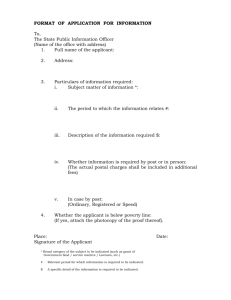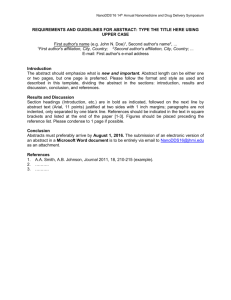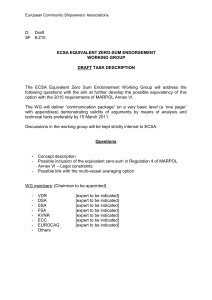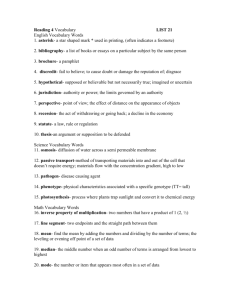Notes - Systematic Reviews
advertisement
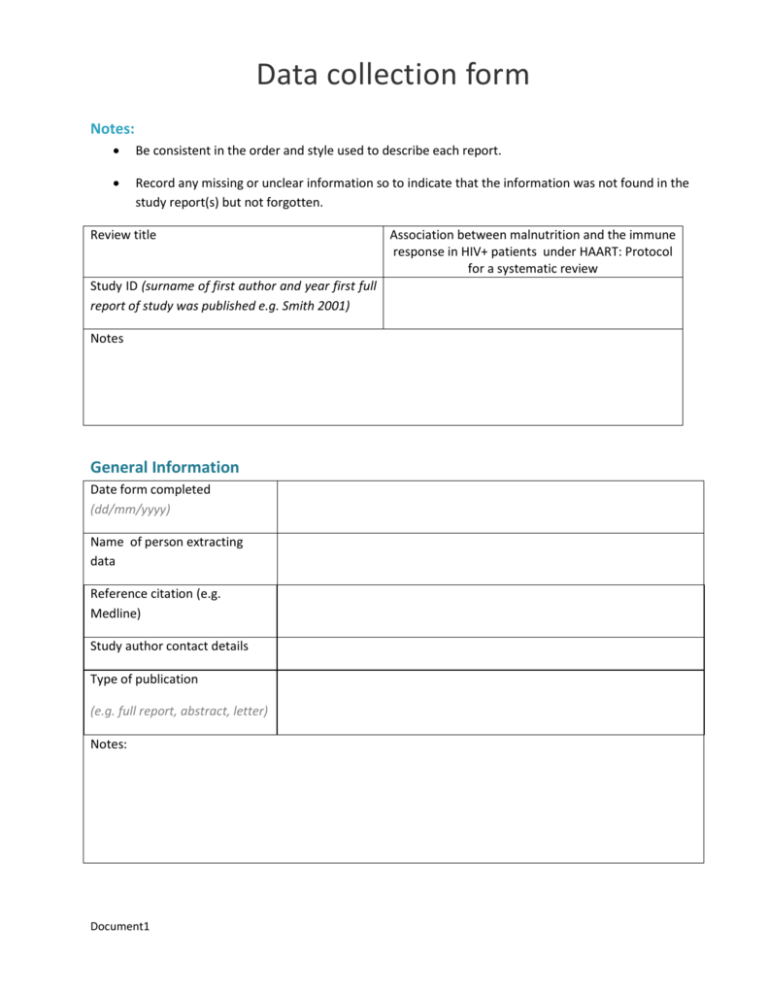
Data collection form Notes: Be consistent in the order and style used to describe each report. Record any missing or unclear information so to indicate that the information was not found in the study report(s) but not forgotten. Review title Study ID (surname of first author and year first full report of study was published e.g. Smith 2001) Notes General Information Date form completed (dd/mm/yyyy) Name of person extracting data Reference citation (e.g. Medline) Study author contact details Type of publication (e.g. full report, abstract, letter) Notes: Document1 Association between malnutrition and the immune response in HIV+ patients under HAART: Protocol for a systematic review Study eligibility Study Characteristics Eligibility criteria Eligibility criteria met? Yes Type of study Participants and setting No Unclear/ unspecified Location in text or source (pg & ¶/fig/table) Experimental study including randomized controlled trials (RCTs) or cluster-randomized trials (CRTs). Quasi-experimental studies including quasi-randomized trials, controlled before-after studies (CBAs) and interrupted time series studies (ITSs). Observational studies including cohort, case-control and cross-sectional studies. HIV-1 infected, adults, non pregnant Low or middle income country setting (as listed in the World Bank Group’s classification of countries by income groups (see Annexe)) Types of comparison Naive to ART (if initiating treatment at T0) or already under ART No known comorbidity (ex. TB, hepatitis, malaria, ....) Undernourished vs well nourished (according to a predefined cutoff value) Types of outcome measures Primary outcome: 1) CD4 counts or CD4% 2) Change in CD4 counts between timepoints Types of determinants Secondary outcomes: 1) Immune failure 2) Time to immune failure Body composition 1) Weight 2) BMI 3) MUAC 4) Skinfold 5) BIA (bioelectrical impedance) Inflammation 1) Albumin 2) Hemoglobin 3) CRP 2 Results Associative measure between one or more dichotomized/categorized nutritional markers OR weight change AND immune response INCLUDE EXCLUDE UNCERTAIN Reason for exclusion Notes: DO NOT PROCEED IF STUDY EXCLUDED FROM REVIEW Characteristics of included studies Methods Descriptions as stated in report/paper Location in text or source (pg & ¶/fig/table) Objectives Design Unit of observation Start date End date Duration of participation (from recruitment to last follow-up) 3 Ethical approval needed/ obtained for study Yes No Unclear Notes: Participants and immune response Description Location in text or source (pg & ¶/fig/table) Population description (from which study participants were drawn) Setting and context (For example, as part of a RCT of nutritional intervention, ...) Inclusion criterions Exclusion criterions Method of recruitment of participants (e.g. phone, mail, clinic patients) Informed consent obtained Total no. of subjects Yes No Unclear/ not indicated Included:_____________________ Excluded:_____________________ Participation agreement (%) 4 Clusters (if applicable, no., type, no. people per cluster) Baseline discrepancies (if applicable) Lost to follow-up How many:____________________ Characteristics of those LTFU: _________________________________________________ _________________________________________________ Statistically different from those who remained? Yes Mortality No Not indicated How many:____________________ Characteristics of those LTFU: _________________________________________________ _________________________________________________ Statistically different from those who remained? Yes Withdrawals No Not indicated How many:____________________ Characteristics of those LTFU: _________________________________________________ _________________________________________________ Statistically different from those who remained? Yes No Not indicated Number of total person-years (if applicable) Missing data 5 Outcome(s) Definition, measure & classification Primary outcome 1) Absolute CD4 counts 2) Relative CD4 counts (% change in CD4 between timepoints) Indicate if used as continuous or categorized (indicate cut-off points used by the authors): ______________________________________________________ ______________________________________________________ ______________________________________________________ Method used to measure CD4 at each time points: 1) FACS counter 2) Other ______________________________________________________ ______________________________________________________ Secondary outcomes 1) Immune failure 2) Time to immune failure Operational definition of immune failure used by the authors: ______________________________________________________ ______________________________________________________ ______________________________________________________ ______________________________________________________ Determinants Body composition Weight Methods of assessment 1. Was the weight auto-reported or measured by an expert Auto-reported Uncertain Measured by expert Not indicated Comments:__________________________________________ 6 BMI Indicate cut-off points used to categorized this variable ______________________________________________________ ______________________________________________________ ______________________________________________________ Methods of assessment 1. Did the observer receive a formal training in BMI measurement Yes Uncertain No Not indicated Comments:__________________________________________ 2. If longitudinal measurements: Did the same observer take all measurements for a same patient Yes Uncertain No Not indicated Comments:__________________________________________ MUAC (mid upper arm circumference) Indicate cut-off points used to categorized this variable ______________________________________________________ ______________________________________________________ ______________________________________________________ Methods of assessment 1. Did the observer receive a formal training in MUAC measurement Yes Uncertain No Not indicated Comments:__________________________________________ 2. If longitudinal measurements: Did the same observer take all measurements for a same patient Yes Uncertain No Not indicated Comments:__________________________________________ 3. At each timepoint, was the measurement repeated 2-3 times and mean value measured Yes Uncertain No Not indicated Comments:__________________________________________ 7 Skinfold Indicate cut-off values used to categorized this variable ______________________________________________________ ______________________________________________________ ______________________________________________________ Methods of assessment 1. Specify anatomical location(s): _________________________ _____________________________________________________ 2. Which brand of Calliper were used Brand: _______________________________________ Not specified 3. Did the observer receive a formal training in SK measurement Yes Uncertain No Not indicated Comments: ___________________________________________ 3. Was the measurement technique calibrated by a second expert in the course of the study Yes Uncertain No Not indicated Comments: ___________________________________________ 4. If longitudinal measurements: Did the same observer take all measurements for a same patient Yes Uncertain No Not indicated Comments:___________________________________________ 5. At each time point, was the measurement repeated 2-3 times and mean value measured Yes Uncertain No Not indicated Comments:__________________________________________ 8 BIA/BIS (bioelectrical impedance) Indicate which compartments were measured/estimated using this technique BCM TBW FFM ICW ECW Phase angle Methods of assessment 1. Were the following factors evaluated and/or taken into account Consumption of water Yes No Consumption of food Yes No Physical activity in hours before measure Yes No Ambient temperature Yes No Medical conditions affecting electrolytes Yes No 2. What was the position of the electrodes Hand-to-foot Hand-to-hand Foot-to-foot Not specified 3. Which BIA/BIS equation was used ______________________________________________________ ______________________________________________________ ______________________________________________________ Not specified 4. If applicable, is the predictive equation used validated for the study population Yes, specified by the authors No, specified by the authors Not specified Inflammatory markers Albumin Indicate cut-off values used to categorized this variable ______________________________________________________ ______________________________________________________ ______________________________________________________ Methods of assessment 1. Was the serum sample Fresh Frozen Not indicated 2. Technique used to measure level of albumin ______________________________________________________ ______________________________________________________ 9 Haemoglobin Indicate cut-off values used to categorized this variable ______________________________________________________ ______________________________________________________ ______________________________________________________ CRP Indicate cut-off values used to categorized this variable ______________________________________________________ ______________________________________________________ ______________________________________________________ Methods of assessment 1. Technique used to measure level of CRP ______________________________________________________ ______________________________________________________ Confounding factors/ effect modifiers accounted for in the analyses Results Crude (specify, e.g. OR, RR, IRR) (specify the reference group) Adjusted Reported limitations of study’s methods/results Key conclusions (as stated in report/paper) 10 Scientific quality (specify tool, e.g. modified EPHPP tool) authors Notes: Other information Study funding sources (including role of funders) Possible conflicts of interest (for study authors) References of relevant studies Correspondence required for further study information (from whom, what and when) Notes: Appendix The World Bank Group’s classification of countries by income groups Available from: http://data.worldbank.org/about/country-classifications/country-and-lending-groups 11 Low-income economies Afghanistan Bangladesh Benin Burkina Faso Burundi Cambodia Central African Republic Chad Comoros Congo, Dem. Rep Eritrea Ethiopia Gambia, The Guinea Guinea-Bisau Haiti Kenya Korea, Dem Rep. Kyrgyz Republic Liberia Madagascar Malawi Mali Mauritania Mozambique Myanmar Nepal Niger Rwanda Sierra Leone Somalia Tajikistan Tanzania Togo Uganda Zimbabwe Lower-middle-income economies Albania Armenia Belize Bhutan Bolivia Cameroon Cape Verde Congo, Rep. Côte d'Ivoire Djibouti Egypt, Arab Rep. El Salvador Fiji Georgia Ghana Guatemala Guyana Honduras Indonesia India Iraq Kiribati Kosovo Lao PDR Lesotho Marshall Islands Micronesia, Fed. Sts. Moldova Mongolia Morocco Nicaragua Nigeria Pakistan Papua New Guinea Paraguay Philippines Samoa São Tomé and Principe Senegal Solomon Islands South Sudan Sri Lanka Sudan Swaziland Syrian Arab Republic Timor-Leste Tonga Ukraine Uzbekistan Vanuatu Vietnam West Bank and Gaza Yemen, Rep. Zambia Upper-middle-income economies Angola Algeria American Samoa Antigua and Barbuda Argentina Azerbaijan Belarus Bosnia and Herzegovina Botswana Ecuador Gabon Grenada Iran, Islamic Rep. Jamaica Jordan Kazakhstan Latvia Lebanon Palau Panama Peru Romania Russian Federation Serbia Seychelles South Africa St. Lucia 12 Brazil Bulgaria Chile China Colombia Costa Rica Cuba Dominica Dominican Republic Libya Lithuania Macedonia, FYR Malaysia Maldives Mauritius Mexico Montenegro Namibia St. Vincent and the Grenadines Suriname Thailand Tunisia Turkey Turkmenistan Tuvalu Uruguay Venezuela, RB 13

